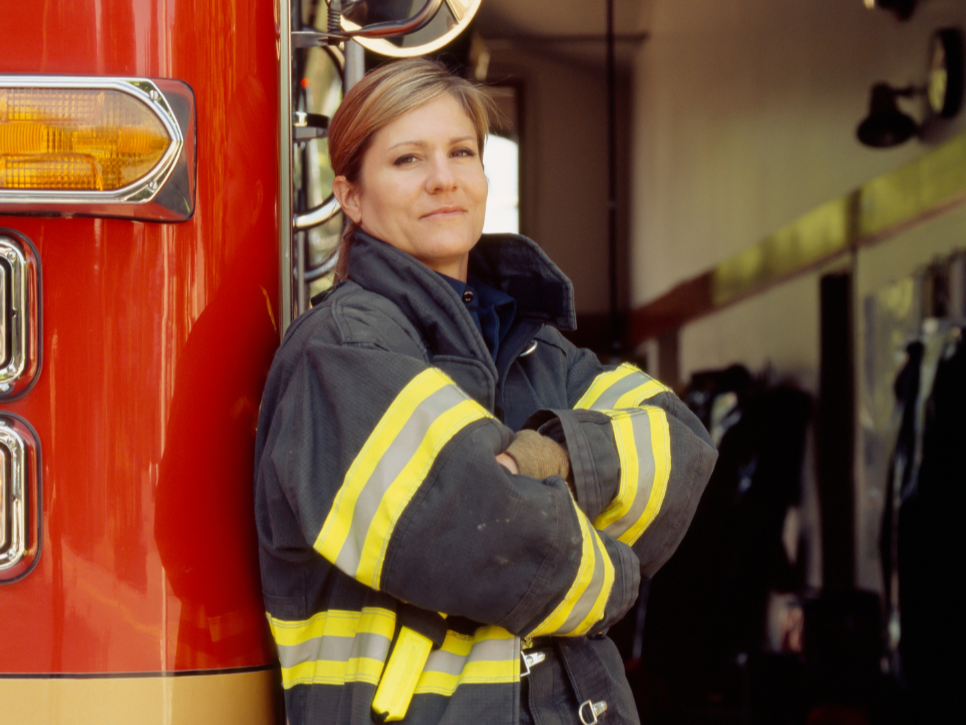Firefighters exposed to chemicals linked with breast cancer
 Study identifies 12 toxic chemicals that put female firefighters at increased risk for the disease
Study identifies 12 toxic chemicals that put female firefighters at increased risk for the disease
It’s well documented that firefighters have significantly higher rates of cancer than the general population, and these elevated rates have been associated with exposures to toxic chemicals on the job. However, most research on cancer in firefighters has been done in men and less is known about the risks in women.
Now a new study by Silent Spring Institute has identified multiple chemical exposures that firefighters face on the job that could increase their risk of developing breast cancer.
“With more and more women entering the profession, it’s important to understand the impact of workplace exposures on their health so that we can inform policies to reduce exposures and create a safer work environment,” says study-co-author Ruthann Rudel, director of research at Silent Spring Institute.
The study appears in the journal Toxics as part of a special issue on firefighters’ occupational exposures and health risks.
Rudel and her colleagues searched through databases from the International Agency for Research on Cancer (IARC) and the U.S. National Toxicology Program to identify chemicals that cause mammary tumors in animals, because these chemicals are likely to increase breast cancer risk. In addition, the team searched for chemicals that have been associated with breast cancer in human studies.
The researchers then identified more than a hundred studies that describe the different chemicals firefighters encounter on the job and screened these studies to see which of these workplace exposures also raise the risk of breast cancer.
The analysis revealed 12 chemicals or classes of chemicals that firefighters are highly exposed to on the job and are associated with breast cancer risk. The chemicals include benzene, PAHs, acetaldehyde, styrene, dioxins, flame retardants, PFAS, and PCBs among others.
Firefighters can be exposed to an array of toxic chemicals when putting out fires—building fires, wildfires, and vehicle fires. They also encounter harmful substances in their protective gear, fire station air and dust, and diesel exhaust from firefighter trucks.
Several years ago, Rudel and her collaborators in California published a study in which they found female firefighters in San Francisco have higher blood levels of cancer-causing PFAS than women working in downtown San Francisco offices. The researchers also found female firefighters have much higher levels of flame retardants, which are also carcinogenic, in their bodies.
Manufacturers add PFAS to firefighter turnout gear and firefighting foams. “But we don’t know where the flame retardants are coming from—they could be coming from the gear or another source,” says Rudel. “If it turns out the chemicals are being added to turnout gear, that would be important to know so that they can be replaced with safer alternatives.”
Similarly, diesel exhaust from fire trucks contains PAHs, so switching to electric trucks would help lower exposures as well, she says. “It’s important to look at all the equipment and materials that firefighters routinely use.”
Understanding the risks women face on the job can not only help change policies to improve worker safety, but also it could help ensure female workers receive the medical care and other benefits they need should they develop breast cancer.
“This study fills an important research gap by underscoring the unique health risks female firefighters face from occupational exposures to toxic chemicals, specifically chemicals linked with breast cancer,” says Dr. Dan Whu, Chief Medical Officer at the International Association of Fire Fighters (IAFF).
According to the IAFF, 20 states currently have presumptive laws that specify breast cancer as an occupational illness. This entitles firefighters to workers' compensation, disability, medical leave, and medical expense coverage if they are diagnosed with the disease. Another 16 other states have laws with less specific language that could allow the inclusion of breast cancer. On the other hand, at the federal level, the current cancer presumptive legislation does not include breast cancer.
“That means there are a lot of places in the country where female firefighters are not protected,” says Rudel. “Hopefully, the findings from our study will change that.”
Funding for this work came from the California Breast Cancer Research Program Grants #19UB-2900 and # 23BB-1700 and Silent Spring Institute’s Safer Chemicals Program, which is funded by charitable gifts.
*Update: On January 6, 2025, the U.S. Department of Labor announced changes to the Federal Employees’ Compensation Act (FECA) to expand the list of presumptive cancers to include breast cancer. "This advancement represents a transformative shift toward equity and recognition of women’s contributions and the protections they deserve given the risks they take and the exposures they face." - Christopher Godfrey, director of the Office of Worker Compensation Programs
Resources or References
Reference:
Cardona B., K.M. Rodgers K.M., J. Trowbridge, H.B. Buren, R.A. Rudel. 2024. Breast Cancer-Related Chemical Exposures in Firefighters. Toxics. 12(10):707. DOI: 10.3390/toxics12100707